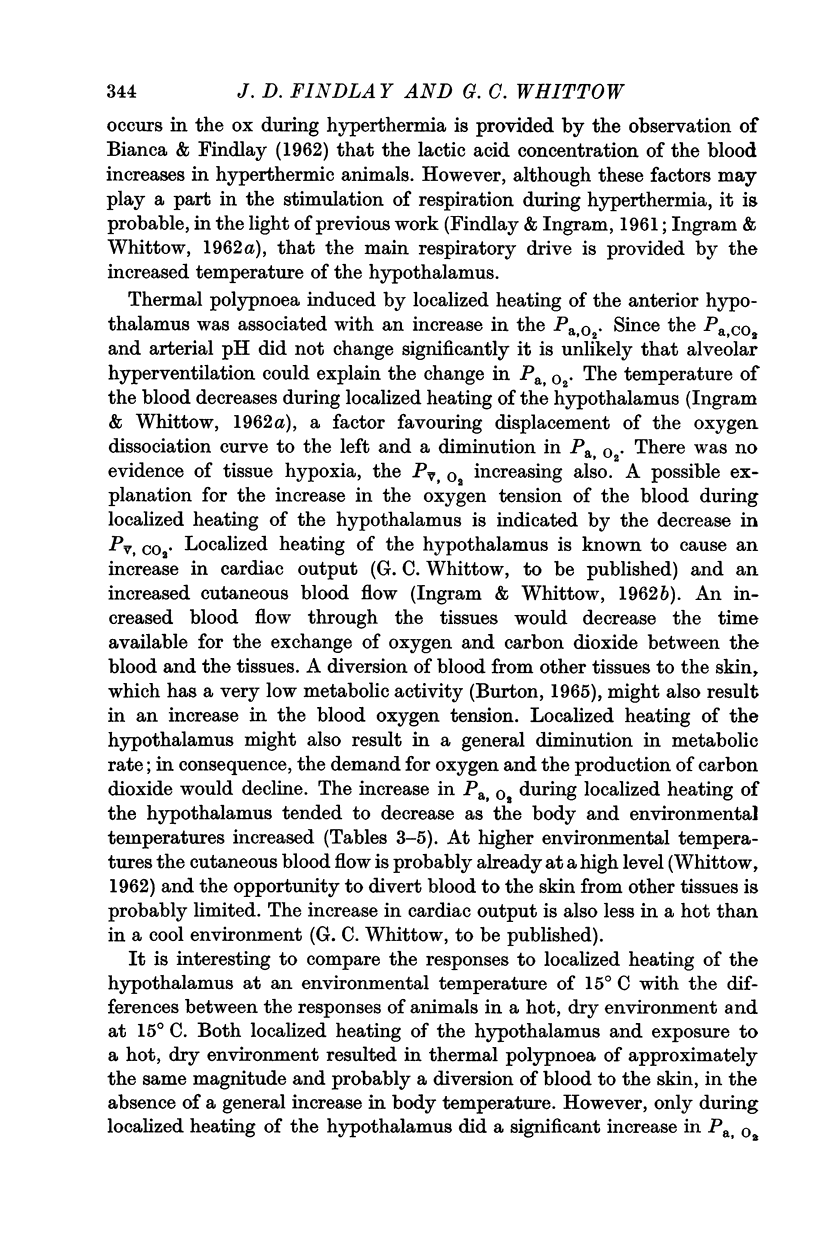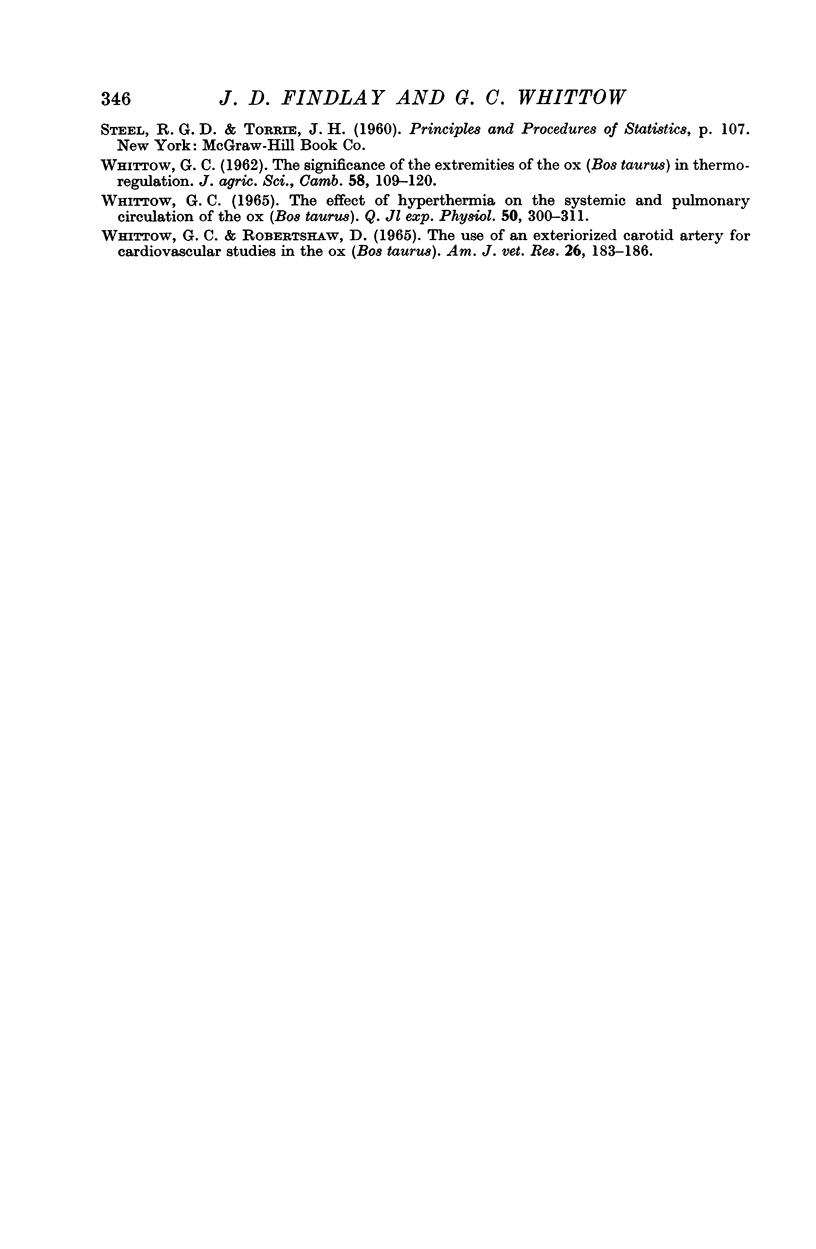Abstract
1. Rectal temperatures, respiratory rates, arterial blood gas tensions, arterial pH and the percentage of red cells in arterial blood have been measured in the unanaesthetized ox in a cool environment (15/12° C, dry bulb/wet bulb [DB/WB]), in a hot, dry environment (40/21° C, DB/WB), during hyperthermia, during infra-red irradiation, and during localized heating of the anterior hypothalamus. In some experiments the gas tensions and pH of mixed venous blood, and the percentage saturation of the arterial blood with oxygen, were also measured.
2. In the cool environment at a mean rectal temperature (Tr) of 38·8° C and a respiratory rate (f) of 28/min the mean values obtained from six animals were: arterial oxygen tension (Pa, O2), 93 mm Hg; arterial carbon dioxide tension (Pa, CO2) 42 mm Hg; arterial pH 7·49; arterial oxygen saturation (Sa, O2) 94%; arterial oxygen capacity (Capa, O2) 13·6 vol.%; arterial packed cell volume (P.C.V.) 29%.
3. Exposure to the hot, dry environment resulted in a small increase in the rectal temperature and thermal polypnoea, but there were no statistically significant changes in the blood gas tensions.
4. During hyperthermia statistically significant increases occurred in rectal temperature, respiratory rate, Pa, O2, pH and arterial haematocrit, while the Pa, CO2 decreased. The venous oxygen tension (Pv̄, O2) decreased also, and the tentative conclusion was made that although the oxygenation of arterial blood remained unimpaired during hyperthermia, tissue hypoxia may supervene. At very high levels of deep body temperature, some evidence for a secondary decrease in Pa, O2 was obtained.
5. Localized heating of the anterior hypothalamus caused an increase in respiratory rate and in Pa, O2. The Pv̄, O2 increased also. These changes were considered to be due to increased cardiac output and diversion of blood to the skin.
6. During infra-red irradiation of three animals at an environmental temperature of 40/21° C, the respiratory rate increased, but the Pa, O2 decreased.
Full text
PDF













Selected References
These references are in PubMed. This may not be the complete list of references from this article.
- BRADLEY A. F., SEVERINGHAUS J. W., STUPFEL M. Effect of temperature on PCO2 and PO2 of blood in vitro. J Appl Physiol. 1956 Sep;9(2):201–204. doi: 10.1152/jappl.1956.9.2.201. [DOI] [PubMed] [Google Scholar]
- FINDLAY J. D., INGRAM D. L. Brain temperature as a factor in the control of thermal polypnoea in the ox (Bos taurus). J Physiol. 1961 Jan;155:72–85. doi: 10.1113/jphysiol.1961.sp006614. [DOI] [PMC free article] [PubMed] [Google Scholar]
- FINDLAY J. D. The respiratory activity of calves subjected to thermal stress. J Physiol. 1957 Apr 30;136(2):300–309. doi: 10.1113/jphysiol.1957.sp005761. [DOI] [PMC free article] [PubMed] [Google Scholar]
- FRANKEL H. M., ELLIS J. P., Jr, CAIN S. M. DEVELOPMENT OF TISSUE HYPOXIA DURING PROGRESSIVE HYPERTHERMIA IN DOGS. Am J Physiol. 1963 Oct;205:733–737. doi: 10.1152/ajplegacy.1963.205.4.733. [DOI] [PubMed] [Google Scholar]
- INGRAM D. L., WHITTOW G. C. The effect of heating the hypothalamus on respiration in the ox (Bos taurus). J Physiol. 1962 Sep;163:200–210. doi: 10.1113/jphysiol.1962.sp006968. [DOI] [PMC free article] [PubMed] [Google Scholar]
- INGRAM D. L., WHITTOW G. C. The effects of variations in respiratory activity and in the skin temperatures of the ears on the temperature of the blood in the external jugular vein of the ox (Bos taurus). J Physiol. 1962 Sep;163:211–221. doi: 10.1113/jphysiol.1962.sp006969. [DOI] [PMC free article] [PubMed] [Google Scholar]
- WHITTOW G. C., ROBERTSHAW D. THE USE OF AN EXTERIORIZED CAROTID ARTERY FOR CARDIOVASCULAR STUDIES IN THE OX (BOS TAURUS). Am J Vet Res. 1965 Jan;26:183–186. [PubMed] [Google Scholar]
- Whittow G. C. The effect of hyperthermia on the systemic and pulmonary circulation of the ox (Bos taurus). Q J Exp Physiol Cogn Med Sci. 1965 Jul;50(3):300–311. doi: 10.1113/expphysiol.1965.sp001796. [DOI] [PubMed] [Google Scholar]


